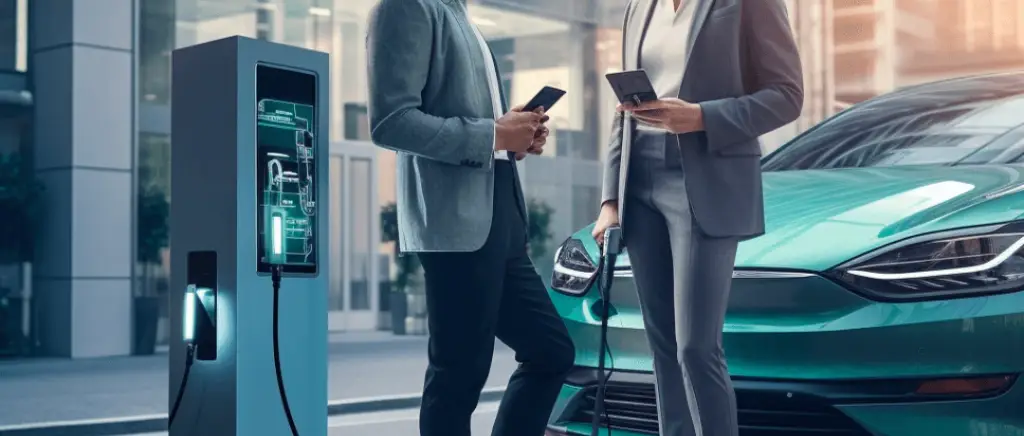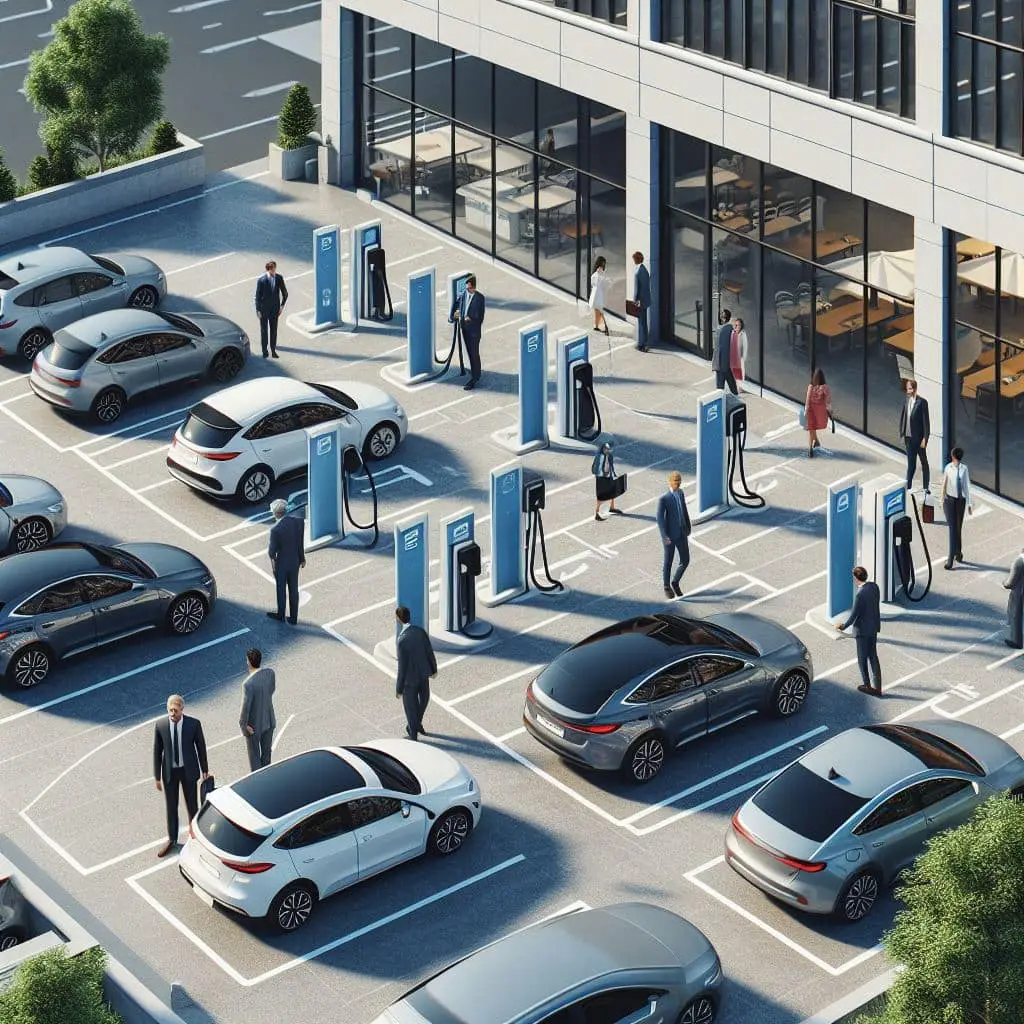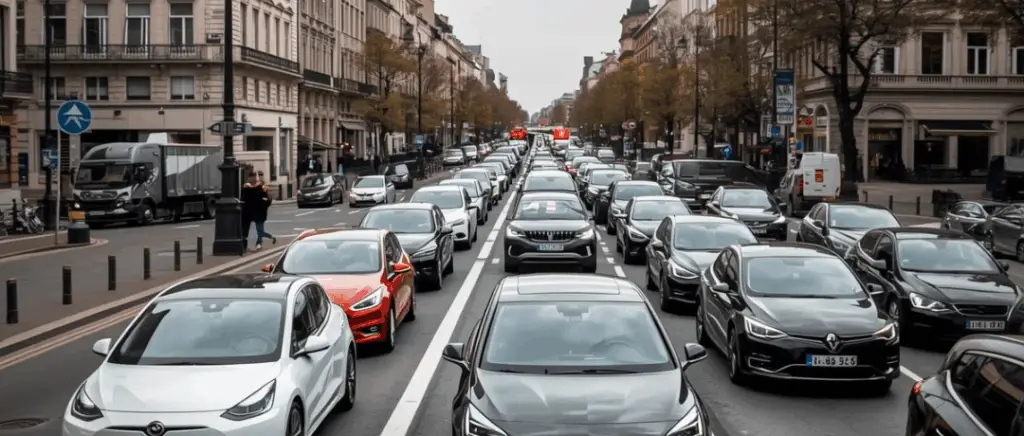Compulsory charging points for businesses: old and new buildings
Company charging points: what does the law say?
According to Article L113-13 of the French Construction and Housing CodeLegislation on the installation of charging points in businesses varies according to the date of construction of the building and the size of the car park.
For the old buildingsFor car parks built before 1 January 2025, existing car parks with more than 20 spaces must be equipped with at least one charging point for electric or rechargeable hybrid cars, accessible to people with reduced mobility.
In addition, for every 20 parking spaces, an extra charging point is required. In the case of company car parks with more than 200 spaces open to the public, at least two charging points must be provided for people with reduced mobility, including one reserved exclusively for PRMs.
For the new buildingsFor buildings with planning permission submitted after 11 March 2021, it is compulsory to pre-equip these buildings.
In concrete terms, at least 1 in 5 parking spaces must be pre-equipped. In addition, 2% of these spaces, i.e. at least 1 space, must be accessible to people with reduced mobility. In car parks with more than 200 spaces, at least 2 spaces must be equipped for PRMs, including one reserved exclusively for this category of user.
What is pre-equipment for recharging electric cars on company premises?
The aim of this proactive approach is to enable the company to prepare for the transition to electric mobility while reducing the costs and potential disruption associated with a later installation. In addition, it sends a strong signal in favour of sustainable development and commitment to more environmentally-friendly transport solutions, which can be beneficial for the company's image and its relationship with its stakeholders.
To sum up, pre-equipping businesses with electric car charging facilities is a very important step towards adapting to new mobility requirements while promoting a sustainable energy transition.
Buildings affected by the obligation to pre-equip terminals
La Mobility Orientation Act (LOM) of 24 December 2019 introduced new provisions for new buildings for which the application for planning permission or prior declaration is submitted after 11 March 2021, as well as for those undergoing major renovations. From now on, there is no longer any distinction between industrial or tertiary buildings, public service buildings and commercial complexes.
All new buildings are now subject to the same requirements for pre-equipping with charging stations. From 11 March 2021, buildings undergoing "major renovation" will also be subject to the same pre-equipment requirements for charging stations as new buildings.
A renovation is considered "major" if its cost represents at least a quarter of the value of the building, excluding the cost of the land. However, if the cost of installing charging and connection systems exceeds 7% of the total cost of the renovation, the pre-equipment obligation does not apply.
For buildings owned and used by SMEs, as well as those falling into a category or located in an area exempt from these obligations, as defined by the PPE, these obligations do not apply.
Residential buildings
Certain parking requirements apply to residential buildings. The conditions under which these obligations apply are as follows:
- The building must be new or have undergone a major renovation that includes the car park or its electrical installation.
- The car park must have more than 10 parking spaces.
- The car park must be inside the building or adjacent to it. This means that it must be located on the same land unit and have a functional relationship with the building.
Regardless of the size of the car park, the minimum mandatory pre-equipment rate is 100% of all parking spaces. In other words, each parking space must be equipped in accordance with these requirements.
Non-residential buildings
Non-residential buildings are subject to obligations in the following cases:
- The building is newly constructed or undergoing major renovation, including the car park or its electrical installation.
- The car park has more than 10 parking spaces.
- The car park is located inside the building or is directly adjacent to it, which means that it is on the same plot and has a functional relationship with the building.
Regardless of the size of the car park, a mandatory minimum pre-equipment rate of 20% of all parking spaces is required, of which 2%, with a minimum of one charge point, must be accessible to people with reduced mobility (PRM).
Mixed-use buildings with predominantly residential use
For residential buildings, obligations are in place under the following conditions:
- The building is new or undergoing major renovation.
- The car park has more than 10 parking spaces.
- The car park is located inside or adjacent to the building, which means that it shares the same property and is functionally linked to the building.
In these cases :
- If the car park has between 11 and 20 spaces, a minimum of 100% of parking spaces must be pre-equipped.
- If the number of parking spaces exceeds 20, the minimum equipment required is as follows 100% seats parking spaces intended primarily for residential use.
For example, if a car park has 100 spaces for residents and 100 spaces for non-residents, then 100% of the 100 places reserved for residents are concerned.
Mixed-use buildings with predominantly non-residential use
For non-residential buildings, requirements must be met in the following cases:
- The building is newly constructed or undergoing major renovation.
- The car park has more than 10 parking spaces.
- The car park is located inside or in the immediate vicinity of the building, i.e. it is on the same property and functionally linked to the building.
In these situations :
- If the car park has between 11 and 20 spaces, a compulsory minimum pre-equipment rate of 20% for all parking spaces is required, of which 2%, with a minimum of one charge point, must be accessible to people with reduced mobility (PRM).
- For more than 20 places, the same minimum pre-equipment rate of 20% applies to parking spaces intended primarily for non-residential use.
For example, if the car park has 100 spaces for residents and 100 spaces for non-residents, then 20% of the 100 places for non-residents are concerned.
Summary table of charging station pre-equipment obligations
| OBLIGATIONS | |||
| No. of spaces to be pre-equipped for car parks with more than 10 spaces | |||
| Between 11 and 20 | > 20 | ||
| Residential buildings (car parks inside or adjoining), new or undergoing major renovation, including the car park or its electrical installation. | 100% | ` | |
| New non-residential buildings (car parks inside or adjoining) or those undergoing major renovation, including the car park or its electrical installation. | 20% of spaces including 2%, with a minimum of one charge point, accessible to PRMs | ||
| New mixed-use buildings or buildings undergoing major renovation* (car parks inside or adjoining) with predominantly residential use | 100% | These same provisions apply pro rata to the number of spaces reserved for residential or non-residential use. | |
| New mixed-use buildings or buildings undergoing major renovation* (car parks inside or adjoining) with predominantly non-residential use | 20% of spaces including 2%, with a minimum of one charge point, accessible to PRMs |
Company charging points: power requirements

In accordance with the decree of 13 July 2016, businesses are required to select electric charging points with a minimum output of 22 kW. However, according to the provisions of the decree of 3 February 2017, they have the option of choosing terminals with a power rating of between 7.4 kW and 22 kW, provided that they are powered by renewable energy sources, such as solar panels, generally.
It is important to note that the law of 10 March 2023 requires every business or local authority to install solar shading if the ground surface area of their parking area exceeds 500 square metres. This obligation takes effect from 1ᵉʳ July 2023. Companies therefore have a clear interest in combining photovoltaic shading with charging stations.
What are the advantages for you as a company of subsidising charging points?
What is the Advenir programme?
To encourage your commitment to the ecological transition as an SME, you can take advantage of the Advenir programme. Initiated in 2017 by ADEME, this programme grants bonuses to companies wishing to install charging stations.
Working with local authorities and players in the energy sector, Advenir combines energy saving certificates (EECs) and public subsidies to promote sustainable mobility. In this way, it offers comprehensive, tailor-made support for each project. Ultimately, the aim is to support the energy transition by financing the development of sustainable mobility.120,000 recharging points to be installed by 2025.
The amount of the subsidy is determined individually for each project, based on an aid rate that varies according to the type of car park, with ceilings ranging from €600 to €960,000 per recharging point:
- A rate of 50 % is applied for a pre-tax ceiling per recharging point ranging from €2,200 to €960,000, intended for a private car park for HGV fleets.
- A rate of 30 % is applied for a pre-tax ceiling per recharging point ranging from €1,000 to €2,700, for a private car park open to the public.
- A rate of 30 % is also applied, with a pre-tax ceiling per recharging point of €1,000, for a private car park open to the public (intermediate target).
- Finally, a rate of 20 % is applied, with a pre-tax ceiling per recharging point of €600, for fleets and employees of short-term vehicle hire companies.
What are benefits in kind?
The management of the benefit in kind (BIN) relating to the cost of recharging electric vehicles in the workplace is attracting particular attention from both employers and employees. Historically, prior to the introduction of the current scheme, which runs until 31 December 2024, the payment of charging costs by the employer was considered a benefit in kind, subject to income tax for the employee. This situation has raised questions about the tax treatment of this benefit.
NOTES FROM 1ᵉʳ JANUARY 2025, FREE CHARGING OF ELECTRIC VEHICLES AT WORK WILL NO LONGER BE AVAILABLE TO EMPLOYEES.
Fortunately, in order to encourage the adoption of electric vehicles and promote the energy transition, the French government has introduced a system of tax relief of 50 % to be applied to the benefit in kind corresponding to the recharging costs borne by the employer, with a ceiling set at €1,800 per year. This measure is designed to lessen the tax impact for employees who use their electric vehicle for business travel and benefit from a recharging point paid for by their employer.
It should be stressed, however, that this reduction in NEA applies exclusively to charging carried out at the workplace. Personal or professional use outside working hours is not taken into account. The aim of this provision is to prevent abuse and ensure that only recharging costs relating to the professional use of the electric vehicle are taken into account when calculating the benefit in kind.
In short, this scheme represents a pragmatic solution for stimulating the adoption of electric vehicles in the workplace, while reducing the tax impact for employees. It demonstrates the government's commitment to promoting more sustainable practices, and contributes to the energy transition and the fight against climate change.
Improving the employee experience and strengthening the employer's image
Offering electric vehicle charging at your site has a number of advantages for enhancing the employee experience. By offering this convenience, employees can optimise their day by avoiding detours to refuel, which increases their satisfaction and loyalty to the company.
What's more, this initiative provides a competitive advantage in attracting talent, particularly those who are sensitive to sustainable development, thereby strengthening the employer brand. By encouraging physical presence at work through a practical recharging solution, companies improve their brand image while reducing travel-related costs. In short, theinstallation of recharging stations The use of electric vehicles on site optimises working time, improves brand image and reduces costs, underlining the importance of making companies aware of these benefits and encouraging them to adopt this practice.
Compulsory installation of charging points by a qualified electrician (IRVE)

Electric vehicle charging stations (IRVE) must be installed by a qualified electrician to ensure safety and compliance with standards. Handling electricity presents potential risks, and incorrect installation can compromise the safety of both users and electrical installations. Calling in a qualified electrician specialising in IRVE ensures that the installation complies with current regulations and guarantees that the charging points are working properly.
What's more, you'll also benefit from expert advice on choosing the best location for the charging points and ensuring that they are used safely and effectively. In short, it's essential to have charging points installed by a qualified electrician to ensure the safety and performance of this equipment.
Since January 2017, it has been a legal requirement that any charging point with a power rating of more than 3.7 kilowatts (kW) must be installed by an electrician who holds the IRVE qualification. For lower-power charging stations, the involvement of an IRVE electrician is not compulsory, but is still recommended to ensure the quality of the installation. The aim of this measure is to guarantee the safety of installations and ensure they comply with standards.
Conclusion
In conclusion, the mandatory installation of electric vehicle charging points in businesses is an essential step in promoting sustainable mobility. This initiative, supported by clear regulations and government incentives such as the Advenir Programme, offers considerable benefits, from improved employee experience to enhanced brand image. By working with qualified electricians, companies can ensure compliance with safety standards and maximise the benefits of this transition to electric mobility, while helping to combat climate change.
For more information, we've put together a guide to this topic to explore the different aspects in depth:
If you would like to find out more about the tax credit for in-car charging points 2024For more information, see our article on this subject.
Read our article about :
Beev is available to provide any information or advice required for the installation of charging stations for professionals or businesses.

































